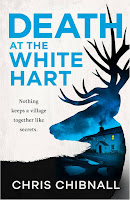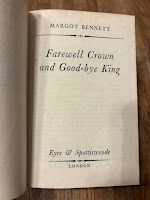The blurb for this British Library Crime Classics edition of a novel first published in 1952 quotes praise from Julian Symons in his landmark study of the genre,
Bloody Murder (1972):
“There are a dozen clever deceptions in the book, twice as many as most writers would have given us.”
I’ve seen some criticism that The Widow of Bath is too complicated, or its protagonists too unlikeable, or that it’s too funny (when, it is implied, murder is a serious business). But I found it fun and then compelling; the last third held me utterly gripped.
We start with Hugh Everton, dining in a down-at-heel seaside hotel — we’re never told where, only that it’s not Bournemouth (p. 25). He is caustic with the Italian waiter about the meagre fare. Then, by chance, in walks Jan Deverill, who has history with Hugh but hasn’t seen him in years.
Jan’s uncle, Gregory Bath, is with her. He’s a respected judge and married to the much younger Lucy, who also has history with Hugh (we learn later that she’s why Hugh and Jan split). Lucy arrives in the company of some other men, one of whom Hugh is certain he recognises — they had some rough dealings previously. Yet he is told he’s got this wrong; this isn’t the same man.
Though Hugh is caustic with everyone, he’s invited back to the Bath residence for more drinks and is the last person to speak to Gregory Bath before the judge is shot dead. But by the time the police arrive, the body has disappeared…
The novel is narrated in the third person from Hugh’s perspective, so really it’s he who observes that this situation is,
“the reverse of the sealed room murder” (p. 47).
Then, when questioned by Inspector Leigh of the local police about the late Judge Bath’s beloved dog, heard outside the house just before the gunshot, Hugh responds,
“He did bark in the night” (p. 50).
This is, of course, a reference to the Sherlock Holmes adventure The Adventure of Silver Blaze (1892), but it's striking that these two references to staple of the crime genre follow in such quick succession. It’s as if the author is offering her credentials: this, she’s saying, will be a reversal or twist on the classic model of a murder mystery.
Agatha Christie did something similar in creating Hercule Poirot; on page 11 of his debut adventure, The Mysterious Affair at Styles (1920), she compares Poirot to Sherlock Holmes and so indicates to the reader that this will be the same kind of story. It’s not just that Poirot is a similar kind of detective (with his own individual quirks) but also the “rules” of the story are the same as in the best of Holmes, allowing the reader a fair chance to crack the case ahead of the detective.
Ronald Knox famously codified these rules in an introduction to The Best Detective Stories of the Year 1928 (1929), in what is sometimes known as his “10 commandments” of detective fiction, or the detection decalogue. The Widow of Bath doesn’t break any of these, as such, but I think it comes pretty close.
Hugh doesn’t light on any clues that are not instantly produced for the inspection of the reader. Yet on several occasions, some new fact or revelation means more to him that it does to us — for example, it relates to his rough treatment with the man he recognises at the beginning of the book, or it’s something he remembers reading about in the papers. It’s not quite playing the game, which I think is why I think aficionados of crime might object.
But I also think this stuff makes the novel more than just a game. What starts as a cosy crime caper riffing on a version of the locked room becomes something a bit stranger and richer.
It’s an odd mix of ingredients. The austere, respectable judge and his young, flighty wife are rather stock characters. There’s a rather Dickensian father, so obsessed with a legal case and his old, out-of-date papers that he neglects his daughter. And then there’s stuff that feels very contemporary.
The plot reminded me of Ian Fleming’s Moonraker, published two years later, which also involves a group of people who are hiding in plain sight. Like Nevil Shute’s The Far Country — from the year before this — there’s an unease about the post-war settlement. Here, Inspector Porthouse notes that, unlike everyone else, criminals are able to save money, in what feels like side-eye at the post-war Labour government:
“They don’t get it all taken off them as tax” (p. 201)
Rather than things being settled by the end of the war, the world continues in chaos, with Hugh listing multiple competing tensions:
“Even now there were plenty of people on the run in Europe. Communists were chasing capitalists; dictators hounding democrats; socialists hunting fascists. People on top everywhere were persecuting the people who had fallen to the bottom; the old scores were a short list compared to the new scores; the secret police were, as usual, being secret only up to a point; their intentions were frequently public and alarming; the results then achieved gave only slender assurance to the law-abiding. The mass activity of armies was restricted; the private efforts of generals, and even, sometimes of corporals, were disastrously free.” (p. 176)
For all this is going on “in Europe”, some of it reaches this quiet seaside town — if only the people there will take the trouble to notice. Early on, Judge Bath is shocked by Hugh’s lack of morality when presented with evidence of a crime. The judge sees things simply:
“And I also advise you that it is the duty of every citizen to expose and so help to destroy evil.” (p. 31).
It seems odd to hear this case being made with no reference to Hugh having recently been demobbed — we presume — from battling Nazis. Notably, there’s little sense of what the various characters did during the war. But I think this is all informed by something else: the author’s time in Spain during the civil war, and her efforts to campaign in London to raise money to battle the fascists. There’s something a little like Casablanca (1942) here: an amoral man hidden away in a coastal resort who encounters an old flame and discovers a cause he will fight for.
I wondered at first if Hugh’s experience of war explained his caustic nature; he;’s a sort of bitter Bertie Wooster. “If you go on like this I’ll have to hit you,” Hugh says to the the grieving widow Lucy (p. 42). He then tells her to think of something cheerful such as what she’ll wear to the murder trial, before adding that this is all a “kind of verbal anti-hysteria slap, containing no malice.”
To some extent, this is a defensive response following his previous rough treatment. We learn that while previously involved with Lucy, Hugh got caught up in a scam that saw him disgraced at work, he was then pushed into the Seine and nearly drowned, before ending up in prison. But this caustic stuff is also familiar from the other Margot Bennett novels I’ve read. As I said of her The Long Way Back (1955), sexual attraction seems to make people more caustic with each other and sex is bound up with the threat of violence.
Despite Hugh’s instincts to protect himself and not get involved in this mystery, he is drawn into investigating the crime. He generally blunders around and at one point it looks as though he has thwarted years of painstaking police work. The inspector duly explodes,
“God spare me from amateurs” (p. 202).
It’s a fun twist on the form to suggest that the amateur detective has in fact hampered the investigation. Yet on the same page it’s suggested that perhaps the police had no idea about the scheme Hugh has uncovered but are pretending otherwise. We’re not sure who to believe.
Things take a more serious turn when Hugh realises that someone else is at risk. There’s palpable horror when it seems Hugh has endangered them. Another character dies and their body also disappears — and the story really picks up. By the end, Hugh has taken on the moral imperative that he dismissed at the start of the novel: he is determined to catch the criminals and see them brought to justice.
We then get twist after twist, pop-pop-pop. I correctly guessed one villain — I’m not sure it’s much of a surprise. But then it turns out that the death of Gregory Bath is not quite what people have assumed. Hugh gets a happy ending but then there’s a coda in which we learn the cost to someone of this cosy caper.
This is a bleak note to end on, again with some ambiguity about exactly what this person will now do. It’s unsettling and lingers in the memory; it is highly effective.
Margot Bennett adapted her novel for television, broadcast by the BBC over six weeks from 1 June to 6 July 1959, with a preview written by Bennett published in Radio Times. John Justin played Hugh, with his real-life wife Barbara Murray as Lucy. Jennifer Wright played Jan (a few months ahead of joining the cast of Garry Halliday in the regular role of Jean Wills). Sadly, the serial doesn’t survive in the archives but it marked a significant shift in Bennett’s career.
She’d previously written a one-off, hour-long TV play, The Sun Divorce, broadcast on 26 January 1956 as part of Associated Rediffusion’s London Playhouse on the relatively new ITV (which launched the previous October), and then wrote 15 episodes of the soap opera Emergency-Ward 10 (1958-59). She also co-wrote two films: The Man Who Liked Funerals and The Crowning Touch (both 1959).
But the adaptation of The Widow of Bath was her first work for the BBC, presumably under the auspices of the head of script department there, Donald Wilson. Over the next few years, she went on to write for a number of major BBC crime and thriller series: The Third Man, Suspense and Maigret.
“It seems that Bennett found screenwriting more lucrative than producing novels at a time when she was also raising a family,” says Martin Edwards (p. 10) in his introduction to the British Library Crime Classics edition of another of her novels, The Man Who Didn’t Fly, originally published in 1955. That book was nominated for the very first Golden Dagger award for best novel of the year, as given by the Crime Writers’ Association. (Until 1960, the Golden Dagger was known as the Crossed Red Herring award).
A later novel, Someone from the Past (1958) won this coveted award and in 1959 Bennett was made a member of the prestigious Detection Club. “She had reached the pinnacle of her profession,” as a crime writer says Edwards, but “astonishingly, she never published another mystery novel, an extreme example of a crime writer going out at the top” (p. 9).
I’m fascinated by all of this: the range of an extraordinary writer, the economics involved, the practicalities, the implicit politics. More to follow when I finish Bennett’s Farewell Crown and Good-bye King (1953).























